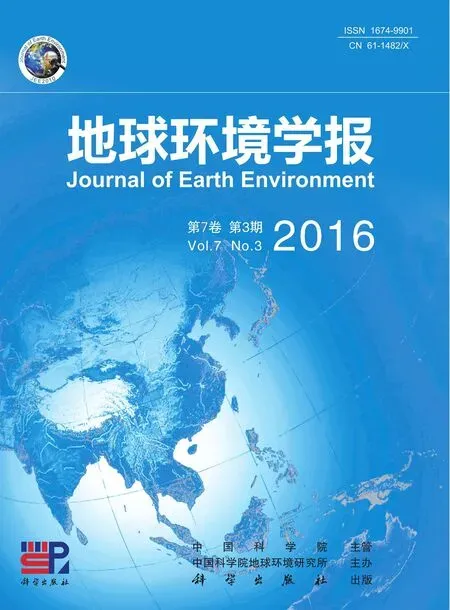河南马沟洞石笋记录的早中全新世气候和环境变化
毛瑞雪,蔡演军,马 乐,成 星
(1.中国科学院地球环境研究所 黄土与第四纪地质国家重点实验室,西安 710061;2.中国科学院大学,北京 100049;3.西安交通大学 全球环境变化研究院,西安 710054)
河南马沟洞石笋记录的早中全新世气候和环境变化
毛瑞雪1,2,蔡演军1,3,马 乐1,成 星1,2
(1.中国科学院地球环境研究所 黄土与第四纪地质国家重点实验室,西安 710061;2.中国科学院大学,北京 100049;3.西安交通大学 全球环境变化研究院,西安 710054)
基于河南省禹州市马沟洞2支石笋(MG-1与MG-40)24个230Th年龄和1988个氧同位素数据,建立了研究区13.1 — 4.9 ka BP分辨率为2 — 14 a的石笋氧同位素时间序列。马沟洞石笋δ18O的时间序列揭示季风降水在11.2 — 9.1 ka BP时段在波动中逐渐增加,9.1 — 4.9 ka BP季风降水显著波动但无明显长期趋势变化。YD事件、9.3 ka事件、8.2 ka事件记录与其他石笋δ18O记录的一致性揭示末次冰消期—早全新世百年—千年尺度气候突变事件的大范围存在和共同的驱动因子。马沟洞全新世大暖期的δ18O记录中检测出的13个数十年尺度的弱季风事件进一步证实全新世大暖期气候的不稳定性。与大气Δ14C记录、NGRIP冰芯δ18O记录的对比及周期分析揭示,太阳活动引起的太阳辐射变化和北半球高纬气候状况共同影响着亚洲季风的变化,ENSO活动及气候系统内部的相互作用也对东亚夏季风降水产生重要的影响。
石笋;δ18O;气候变化;夏季风降水;全新世;马沟洞
河南省地处黄河中下游地区,在地形、气候、水系、植被等地理要素方面具有东西过渡、南北兼具的特征(李中轩等,2013),特殊的地理位置一方面导致这一地区对气候敏感响应,另一方面也成为中原文明的核心区域。该区域过去气候和环境变化的研究既有助于深刻认识东亚季风气候对我国东部平原地区的影响,也可为查明中原文明演替与气候变化的关系提供重要的环境变化信息。洞穴石笋由于具有可精确定年、高分辨率采样、沉积时间跨度大、后期没有扰动等诸多优势,已成为古气候研究的重要载体之一(马乐等,2015)。目前有关河南地区石笋研究较少,已报道的石笋研究主要集中在豫西山地丘陵区,例如栾川县的东石崖洞、老母洞、鸡冠洞,南阳伏牛山地区的南阳洞穴。这些研究中有关洞穴监测、洞穴滴水及现代沉积物微量元素记 录研究较多(马睿,2013;任小凤等,2014;赵景耀等,2014),石笋氧、碳同位素研究较少,且研究时段主要集中在早全新世。任晓辉等(2006)通过对南阳洞石笋碳、氧同位素记录进行对比研究,确认了研究区6115 — 4544 a BP期间发生了3次弱季风事件,其中5350 — 5080 a BP、4770 — 4640 a BP弱季风事件可与格陵兰冰芯记录的降温事件相对应,认为亚洲季风在百年尺度上与高纬极地气候变化存在遥相关。Cai et al(2008)研究发现东石崖洞DSY09记录的早全新世11.5 — 9.0 ka BP 8次百年 — 十年尺度弱季风事件与格陵兰冷事件在测年误差内一致,进而指出东亚季风强度与太阳活动相关。张银环等(2015)通过对老母洞研究发现在测年误差范围内LM2石笋δ18O与格陵兰GRIP冰芯δ18O记录有着较好的一致变化,并记录了8.2 ka、9.5 ka、10.2 ka、10.9 ka弱季风事件,认为早全新世亚洲季风的演化与太阳活动变化引起的太阳辐射能量的变化和北半球高纬气候的变化状况有关。
本文基于河南禹州马沟洞石笋230Th定年结果和δ18O测试数据,建立了该地区13.1 — 4.9 ka BP(相对于1950 a AD)时段石笋δ18O的高分辨率时间序列,结合已有石笋δ18O记录,探讨早中全新世区域降水变化的特点和机理,并在此基础上讨论了文明演替与气候变化的可能联系。
1 研究区域和石笋样品
马沟洞(113°23′E,34°19′N,海拔422 m)位于河南省许昌市下辖的禹州市马沟村(图1),距离郑州市区西南约50 km。马沟洞地处豫西山地丘陵区向黄淮海平原区的过渡地带,发育于禹州市北部具茨山系奥陶纪灰岩地层中,上覆岩层厚约20 m,洞外植被以灌草为主。区域气候属于暖温带季风气候,主要受高纬冷高压南下的冷干气流(冬季风)和来自印度-太平洋的暖湿气流(夏季风)交替影响。冬季寒冷少雨雪,春季干旱多风沙,夏季炎热而降雨集中,秋季晴和气爽且日照充足。年平均降雨量为705.6 mm左右,各季节降水量分布悬殊,6 — 9月雨水最为集中,平均为439.9 mm,占年平均降水量的62.3%(数据来自许昌1971 — 2000年资料统计)。历年年均气温在13.0 — 16.0℃,年平均无霜期为218天。该洞穴被采石场采石发现之前是一个封闭的洞穴,没有开放的洞口。虽然在洞口炸开后没有进行洞穴环境监测,但可以认为该洞穴的温度变化基本响应于地表年均温的变化,洞内湿度接近饱和状态,应十分适合古气候重建研究。
所研究石笋样品编号分别为MG-1、MG-40(图2)。石笋MG-1总长度约260 mm。该石笋沿生长轴剖开并进行剖光后可见清晰的生长纹层,其中距顶部148 — 260 mm段生长轴多次发生改变,195 — 260 mm纹层致密,生长速度缓慢。MG-1采样时断开,分别标号为MG-1A、MG-1B。MG-1A顶部缺失,颜色为黄色,纹层清晰,整体上纹层较稀疏,生长速度快。MG-1B整体上淡黄色、棕色相间,66 — 100 mm段和148 — 260 mm段为淡黄色。石笋MG-40总长度约40 mm,整体呈暗黄—棕色,样品下部18 mm出现多条明显的沉积间断,最下部8 mm为基座部分,土黄—白条纹相间,表明碎屑质的显著增多。
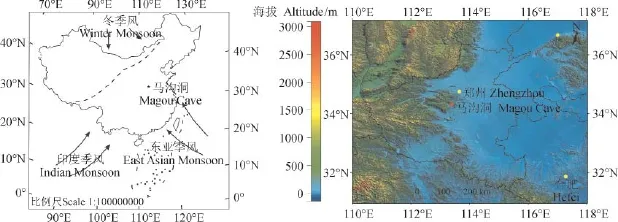
图1 马沟洞地理位置示意图Fig.1 Geographical location of Magou Cave

图2 马沟洞石笋(MG-1、MG-40)剖面图及年代、测年样点位置以及年龄-深度模式图(黑点表示测年点位置;黑色横线为误差)Fig.2 The fi gures of the polished sections with position of dating samples and the age-depth model of the two stalagmites (MG-1, MG-40) from Magou Cave
2 实验分析方法与结果
在石笋抛光面上确定测年点位置后,沿着生长纹层方向用0.5 mm牙钻共取得24个测年样品,单个样品质量约为70 — 120 mg。年代样品在西安交通大学全球环境变化研究院U-系年代学实验室测试完成,测试仪器为MC-ICP-MS Neptune,铀钍化学分离使用Edwards et al(1987)建立的化学流程,仪器测试使用Cheng et al(2013)建立的测试方法,年龄误差(2σ)≤1%,测试结果见表1。年代标尺采用线性插值方法,对于测年点以外部分的年代,使用邻近部分的沉积速率进行外推计算。

表1 马沟洞石笋230Th测年结果Tab.1230Th dating results of stalagmites in Magou Cave
如表1、图2所示,除MG1B-3S和MG40-1232Th相对较高导致年代误差较大外(分别为±168、±784),其余样品点测年误差均为±28 — ±80。尽管MG1B-3S和MG40-1两个样品误差较大,但所测样品年龄均按沉积先后序列正常排列,没有出现年龄倒转。同时对疑似沉积间断的两侧做了年代测定,认为不存在沉积间断,或沉积间断的时间很短,并不影响本文相关的气候变化讨论。本文通过对相邻实测年代点进行线性等间距内插与外延,建立了石笋剖面13.1— 4.9 ka BP年代框架。MG-40生长较慢,13.1— 9.8 ka BP和9.8— 7.1 ka BP生长速率分别为1.5 μm · a-1、6.3 μm · a-1;MG-1总体生长较快,10.3— 8.6 ka BP和8.6— 4.9 ka BP生长速率分别为4.7 μm · a-1、58.6 μm · a-1。图2为两个石笋的年代模式图,显示两个石笋在开始沉积时速率较慢,随后增大并基本保持不变。
本文石笋碳、氧同位素样品使用Micro-mill微取样装置采取。石笋MG-40的采样间距为50 μm,MG-1A在0 — 3.6 mm的采样间距为50 μm,其他样品的采样间距均为150 μm。MG-40、MG-1A、MG-1B分别采取439个、381个和1168个子样品进行碳氧同位素组成分析。碳、氧同位素分析测试全部在中国科学院地球环境研究所洞穴实验室完成。分析方法采用磷酸法(McCrea,1950),分析仪器为IsoPrime100稳定同位素质谱仪,在分析测试时每10个同位素样品内插一个标准NBS-19,使用已知同位素组成的高纯CO2气体为参考气,δ=(Rsample/Rstd-1)×1000,其中R=18O /16O,δ值相对于PDB标准给出,分析误差(2σ)≤± 0.08‰。
图3为马沟洞石笋MG-1和MG-40δ18O变化的时间序列。石笋MG-1涵盖的5479年内共测试碳氧同位素1168对,平均分辨率约4.7年。整个δ18O序列没有明显的变化趋势,δ18O值的变化范围为-12.7‰ — -9.2‰,平均值为-10.5‰,波动幅度达3.5‰。石笋MG-40涵盖的6075年内共测试碳氧同位素439对,平均分辨率约14年。δ18O值的变化范围为-11.9‰ — -8.4‰,平均值为-10.4‰,波动幅度达3.5‰。与δ18O的变化相比,两个石笋δ13C的高频大幅波动变化并不明显,仅表现出长期变化趋势。
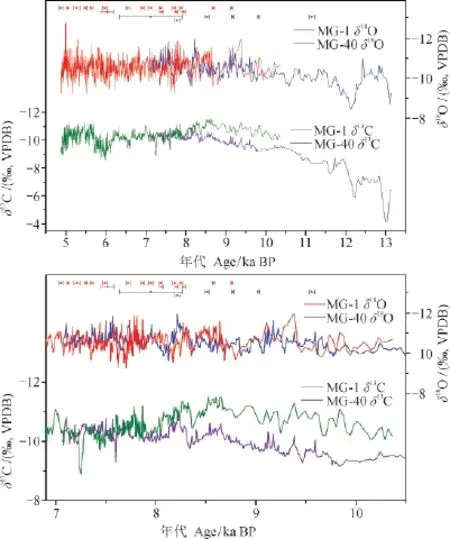
图3 马沟洞石笋(MG-1、MG-40)氧、碳同位素序列(上图)及相同时段(10.37 — 7.06 ka BP)两支石笋氧、碳同位素序列重复性对比图(下图)MG-1氧、碳同位素序列分别用红色和绿色线条表示,MG-40氧、碳同位素序列分别用蓝色和紫色线条表示。Fig.3 Theδ18O andδ13C time series of the two stalagmites (MG-1, MG-40) of Magou Cave (top panel), and comparisons of theδ18O andδ13C profi les during the overlapped time period (10.37 — 7.06 ka BP) (lower panel)Theδ18O andδ13C time series of the stalagmite MG-1 are shown by the red and green lines, respectively. Theδ18O andδ13C time series of the stalagmite MG-40 are shown by the blue and purple lines, respectively.
3 讨论
3.1 石笋碳酸盐δ18O的气候意义
应用石笋氧同位素组成重建古气候和古环境变化的前提条件之一就是石笋碳酸盐在平衡条件下沉积。重复性检验是目前洞穴石笋研究的主要检验准则。重复性检验的内容就是不同石笋样本相同时段的δ18O如果能够重复,那么这些石笋样本沉积时受到动力分馏作用的影响就很小或可以忽略不计,石笋碳酸盐δ18O就可以用作古环境重建(Dorale et al,1998;Wang et al,2001),反之,石笋碳酸盐δ18O的古气候和古环境解译就需慎重。本论文研究的MG-1和MG-40在相同时段内(10.37— 7.06 ka BP),尽管因测年误差和样点分辨率不同,δ18O记录在部分细节上存在差异,如8.25— 8.0 ka BP、9.2—9.0 ka BP阶段,δ18O记录的峰谷存在些许偏差,但总体上MG-1和MG-40在这一时段能够较好地对应(图3)。除此之外,石笋MG-40的δ18O也和东石崖洞石笋δ18O记录在重叠时段具有一致的变化趋势和特征。这些证据说明马沟洞石笋是在同位素平衡分馏状态下沉积的,其δ18O变化能够真实地记录气候和环境变化信息。
在平衡条件下沉积的石笋碳酸盐,其δ18O值受滴水的δ18O和洞穴温度的共同影响。马沟洞石笋碳酸盐δ18O由冰消期至早全新世的变化幅度为3.5‰,且早中全新世的波动幅度最大也可达2.5‰。仅用温度的变化很难解释这么大振幅的δ18O的变化,因为洞穴滴水与碳酸盐之间的氧同位素组成分馏的温度效应很小,只有-0.23‰ ·℃-1(Kim and O'Neil,1997),而早中全新世中国东部的温度变化也不会超过3℃(温度变化造成的碳酸盐δ18O的波动不会超过0.75‰)。因此,石笋碳酸盐δ18O的变化主要反映滴水的δ18O变化,也就是降水同位素组成的变化。邻近的郑州气象站(1985— 1992年)器测降水资料(图4)表明,夏季风控制期间(6— 9月)δ18O值偏轻,平均值约为-7.4‰,且夏季降水量约占全年降水量的62.3%,夏季风强弱变化引起的降水量变化就成为影响区域降水δ18O组分的主要因素,因为夏季季风降水量的变化或者其引起的夏季降水和冬季降水的比值的变化,均能导致年均大气降水δ18O的显著变化。尽管温度是影响冬春季节大气降水δ18O的主控因子(Johnson and Ingram,2004),但由于洞穴滴水-碳酸盐的温控分馏大体上抵消大气温度对降水δ18O的影响(Johnson et al,2006),因此温度变化的影响较小,这里不做讨论。综合上述的分析,可以认为马沟洞石笋碳酸盐δ18O变化主要指示了季风降水的变化,δ18O值减小,季风降水增加,δ18O值增加,季风降水减少。

图4 郑州市1985 — 1992年月均降水量、月均温与大汽降水δ18O值对比Fig.4 Monthly average precipitation, temperature and precipitationδ18O during 1985 — 1992 in Zhengzhou
3.2 石笋δ18O记录的早中全新世区域气候和环境变化
马沟洞石笋δ18O序列有以下两个特点:(1)MG-1δ18O序列在百年至数十年尺度上变化的振幅大于葫芦洞和董哥洞。这也与东石崖洞δ18O记录相类似,可能表明马沟洞临近干湿区分界线(南部湿润区和北部半干旱区),且处于豫西山地丘陵区向黄淮海平原区的过渡地带,对夏季风强度变化极其敏感。(2)马沟洞δ18O值由9 ka BP直至5 ka BP一直未出现明显偏正的变化趋势,而董哥洞、和尚洞δ18O记录显示在8 — 6 ka BP,石笋碳酸盐δ18O已经开始增加,亚洲季风逐渐减弱、夏季风降水减少,进一步支持了较早发现的全新世中国中东部地区东亚夏季风降水变化具有不同步性,南部季风降水量开始减少的时间较早,北部则较晚(Cai et al,2010),但由于缺失晚全新世数据,本文对此不进行深入讨论。
马沟洞石笋δ18O记录,提供了河南地区13.1 — 4.9 ka BP的气候变化信息。依据δ18O变化特征,这一记录大致可以划分为13.1 — 11.2 ka BP、11.2 — 9.1 ka BP和9.1 — 4.9 ka BP三个时段。其中13.1 — 11.2 ka BP的年代是根据沉积速率线性外延得到,其δ18O变化特征及与董哥洞、葫芦洞的对比(图5)表明该阶段可能对应于Allerød暖期和YD事件,但由于分辨率较低和年代标尺的可靠性较低,在此不做详细讨论。
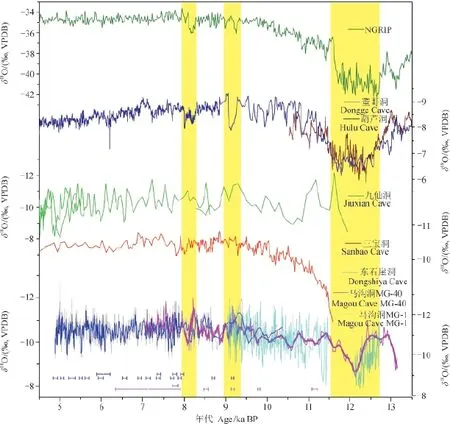
图5 马沟洞石笋δ18O曲线与格陵兰冰芯δ18O及董哥洞、葫芦洞、九仙洞、三宝洞和东石崖洞石笋δ18O曲线对比图Fig.5 The comparison ofδ18O record from Magou Cave (the blue line and the magenta line are 9-point running average) and the NGRIPδ18O record (green, Rasmussen et al, 2006; Vinther et al, 2006) and theδ18O profi les of stalagmites from the Dongge (sea blue, Dykoski et al, 2005; Wang et al, 2005), Hulu (brown, Wang et al, 2001), Jiuxian (light green, Cai et al, 2010), Sanbao (red, Wang et al, 2008), Dongshiya (cyan, Cai et al, 2008) caves in Asian monsoon region
(1)11.2 — 9.1 ka BP,石笋δ18O值由老至新呈现较明显的减小趋势,变化范围-11.43‰ —-9.7‰。该时段石笋δ18O持续降低指示的夏季风加强过程被几个百年尺度的弱季风事件打断。MG-40δ18O记录的弱季风事件年代中心点为11.2 ka BP、10.6 ka BP、9.8 ka BP和9.1 ka BP,与Cai et al(2008)在东石崖洞记录中发现的弱季风事件在误差范围内有很好的对应,进一步证实了早全新世东亚季风气候的不稳定性。
(2)9.1 — 4.9 ka BP,该阶段石笋δ18O变化趋势总体上比较稳定,平均值为-10.51‰,其中9.1 — 8.6 ka BP存在长达约500年的弱季风(夏季降水减少)时期。至5 ka BP,δ18O值一直处于较偏负水平,5 — 4.9 ka BPδ18O逐渐增加,指示了一个季风降水减少的事件。此后该石笋停止生长,可能指示了夏季风降水的系统性减少。
3.3 YD、9.3 ka、8.2 ka气候突变事件的区域特征
已有研究结果表明(Wang et al,2001;Denton et al,2010),由北大西洋大量淡水的注入引发的YD事件(12.9 — 11.5 ka BP)是末次冰期向全新世转换、急剧升温的过程中一次快速降温事件,该时期东亚地区出现千年尺度亚洲夏季风减弱的状况。Ma et al(2012)和Liu et al(2013)通过中国中北部石笋(青天洞、苦傈树洞)230Th和纹层计数定年基础上的δ18O记录,认为YD事件开始于约12.9 ka BP,历经约340年,而在11.5 ka BP左右YD事件向早全新世转变在小于20年内完成,这在NGRIP冰芯δ18O记录和葫芦洞都有体现(图5)。YD事件时东石崖DSY09石笋出现沉积间断风化层,马沟洞石笋δ18O值偏正达-8.5‰,反映了区域夏季风降水减少、气候较干旱的状况。
9.3 ka左右事件是一个百年尺度上的显著弱季风事件,已被多数学者证实(Fleitmann et al,2003;Dykoski et al,2005;Cheng et al,2012)。Bond事件中记录有9.4 ka BP冷事件,NGRIP冰芯记录到该冷事件的时间中心点大致在9.0 ka BP和9.2 ka BP,三宝洞记录到该冷事件的时间中心点大致在9.1 ka BP和9.3 ka BP,董哥洞、九仙洞记录到该冷事件的时间中心点大致都在9.1 ka BP,河南地区东石崖石笋DSY09记录存在9.2 ka BP和9.4 ka BP弱季风事件,马沟洞MG-40石笋δ18O值也在9.1 ka BP和9.3 ka BP左右快速偏正,这些记录说明在早全新世9.3 ka BP左右确实存在一个快速震荡的弱季风时期。这一事件可能主要受融冰淡水脉冲作用的影响,发生冷事件时,北大西洋表层为融冰淡水控制,抑制了北大西洋深水(NADW)的形成,使北大西洋经向环流(AMO)的强度减弱,向北输送的热量大为减少,造成北大西洋地区气候的变冷和海冰范围的扩大。北大西洋地区的变冷一方面使得西风环流向南摆动,另一方面通过西伯利亚高压的加强而增强东亚冬季风,进而导致东亚夏季风的减弱和季风降水的减少(Sun et al,2012)。
来自世界各地区的记录显示8.2 ka事件可能是全新世最强的冷干事件。中国南北方石笋δ18O记录的8.2 ka BP事件与格陵兰NGRIP冰芯δ18O记录的8.2 ka事件相一致(图5),体现了高纬气候系统与中低纬季风之间存在遥相关关系。Dong et al(2015)通过分析山西莲花洞、湖北和尚洞、贵州董哥洞8.2 ka BP事件δ18O变幅,认为自北向南δ18O变幅减小说明自北向南干旱程度减轻,马沟洞8.2 ka BP事件δ18O变幅约为1.9‰,较董哥洞(~0.8‰)变幅增大一倍多,与这种区域变化特征一致,但笔者认为由于区域气候等差异存在,中国南北8.2 ka BP事件中石笋碳酸盐δ18O值的差异是否就指示了不同区域干旱程度的不同,还需要更多数据支持和证实。
3.4 石笋δ18O记录的全新世大暖期内部的气候波动
施雅风等(1992)认为中国的大暖期出现于8.5 — 3.0 ka BP,估计大暖期温度比现今高2℃左右,华北等地可能高3℃,华南仅高1℃。大暖期气候波动阶段可划分为:(1)8.5 — 7.2 ka BP不稳定的温度波动阶段;(2)7.2 — 6 ka BP大暖期中稳定的暖湿阶段(大暖期的鼎盛期);(3)6 — 5 ka BP气候波动剧烈、环境较差阶段;(4)5 — 3 ka BP大暖期结束时的不稳定波动阶段。大暖期并不是持续稳定的温暖湿润期,期间存在多次气候波动和低温干旱事件,这一观点已得到大多数学者证实(施雅风等,1992;何元庆和章典,2003;彭晓莹等,2005)。
图6显示全新世大暖期,马沟洞MG-1石笋δ18O记录在总体稳定背景下,存在多个数十年尺度的波动变化,最大振幅可达2‰。根据波动特征,马沟洞全新世大暖期的δ18O记录大致可以分为8.0 — 7.3 ka BP不稳定的波动阶段、7.3 —6.1 ka BP稳定阶段、6.1 — 5 ka BP气候剧烈波动阶段等三个阶段,大致与施雅风等(1992)的划分相一致。为了凸显研究区大暖期出现的气候事件,将8000 — 4881 a BPδ18O曲线按0.4年进行等间距线性内插,在此基础上做50年加权平均,得到13个弱季风时期(从老到新依次命名为WM1—WM13),年代中心点从老到新依次为7.7 ka BP、7.6 ka BP、7.35 ka BP、7.1 ka BP、6.9 ka BP、6.6 ka BP、6.24 ka BP、6.1 ka BP、6.0 ka BP、5.7 ka BP、5.5 ka BP、5.3 ka BP、5.2 ka BP。
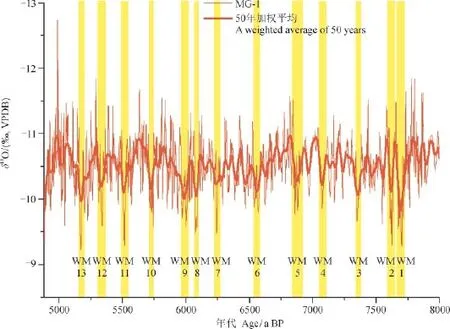
图6 全新世大暖期MG-1δ18O记录的13次弱季风事件Fig.6 The thirteen weak monsoon events (yellow bars, numbered with WM1—WM13) identifi ed in MG-1δ18O record during the Holocene Megathermal
这些夏季风减弱时段中,WM1(7637 —7605 a BP)和WM2(7707 — 7671 a BP)时期MG1石笋δ18O值出现强烈偏正,比8.2 ka事件时还偏正0.31‰,指示该时段夏季风强度/降水在数十年尺度上的大幅振荡。祁连山敦德冰芯δ18O在7.8 — 7.1 ka BP出现三次降温事件,与MG-1石笋δ18O记录的不同之处是在7.3 ka BP降温幅度最大(章新平和姚檀栋,1993)。位于6.1 ka BP、6.0 ka BP的WM4和WM5可能是大暖期鼎盛期向气候大幅波动、夏季风减弱变化的转折点,贵州七星洞石笋δ18O值在6.0 ka BP也呈现出显著下降(蔡演军等,2001)。河南伏牛山南坡南阳洞石笋δ18O记录显示在5830 — 5720 a BP和5350 — 5080 a BP时段发生弱季风事件(任晓辉等,2006);内蒙古西部阿拉善高原的湖泊沉积物在7 — 5 ka BP,尤其是6.2 ka BP、5.5 ka BP时段,总体孢粉浓度较低,且95%是耐旱生的白刺植物花粉,说明当时湖面较低、气候异常干旱(陈发虎等,2004);敦德冰芯δ18O在5.9 ka BP、5.3 ka BP明显偏负,出现显著的降温事件,这些记录进一步印证了6.1 —5 ka BP是气候波动剧烈、环境变化相对较大的阶段。
3.5 9.1 — 4.9 ka BP气候变化的周期特征与驱动因子
采用REDFIT38功率谱分析软件(ofac、n50、iwin参数分别为3.0、2.0、1)对马沟洞MG-1石笋顶部至198 mm段的δ18O序列(7881 — 4881 a BP,平均分辨率为2 a)进行周期分析,在99%置信度水平下通过红噪声检验的周期有22 a、19 a、8 a、7 a、6 a,在95%置信度水平下通过红噪声检验的周期有272 a、83 a、36 a、15 a、11 a、10 a、5 a(图7)。22 a和11 a周期与树轮Δ14C(大气中14C的浓度)检测出来的周期一致,对应于太阳黑子活动的22 a周期(Kurths et al,1993),83 a和太阳活动世纪周期(70 — 100 a的变化周期,Gleissberg周期)吻合。这些检测出来的周期与亚洲季风区早中全新世其他高分辨率记录(Cai et al,2008,2010)检测出的太阳活动周期相一致,说明马沟洞石笋记录的短尺度夏季风变化与太阳活动密切相关。5 — 7 a周期成分与现今ENSO活动周期相对应。赵景耀等(2014)通过对河南鸡冠洞降水-洞穴滴水-洞穴现生碳酸钙的δ18O变化特征分析,认为栾川地区大气降水δ18Op对“环流效应”和水汽来源的强弱变化更加敏感,表现为与ENSO循环的正相关,可能与降水中不存在显著的温度效应和雨量效应等噪音因素影响有关,鉴于洞穴碳酸钙对大气降水δ18Op的信号具有良好的继承性,本文支持这一观点。前人研究表明(李崇银,1992;王绍武,2001)地处夏季风锋面区域的华北地区,夏季降水与ENSO关系较为明确,El Niño年夏季平均降水量一般较少,El Niño事件所引起的热带和副热带大气环流的异常,尤其是西太平洋副热带高压的异常是造成华北地区汛期降水量异常的重要原因之一。另外,通过7881 — 4900 a BP时段马沟洞石笋MG-1δ18O序列功率谱与大气Δ14C记录、NGRIPδ18O序列功率谱对比发现,MG-1δ18O序列与大气Δ14C记录共有的周期有83 a、36 a、22 a,与NGRIPδ18O序列共有的周期为56 a,和大气Δ14C记录的59 a周期相近。说明该时段十年至百年尺度上研究区域夏季风变化主要受太阳活动及北半球高纬地区气候变化影响,年际尺度上受ENSO影响显著。
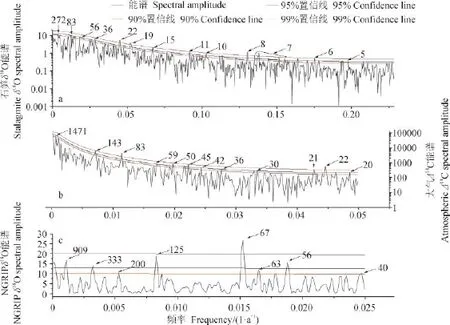
图7 马沟洞石笋MG-1δ18O序列功率谱分析结果(a)及与相同时段(7881 — 4881 a BP)大气Δ14C记录(b)、NGRIPδ18O序列(c)功率谱对比Fig.7 Power spectral analysis of the stalagmite MG-1δ18O sequence (a) from Magou Cave and the comparison with the power spectral analyses of atmosphericΔ14C record (b) and the NGRIPδ18O record (c) during the period of 7881 — 4881 a BP
大气Δ14C的变化与太阳活动变化相联系,可以作为太阳活动的代用指标(Dykoski et al,2005)。图8中马沟洞石笋MG-1δ18O与大气Δ14C去趋势曲线在百年尺度上存在相似变化,说明在百年乃至几十年尺度上太阳活动是亚洲季风强度变化的驱动因素之一。然而,对比还发现7429 — 7137 a BP和6067 — 5924 a BP两者存在反相位变化,7429 — 7137 a BP时段最为明显,这很难用年代误差来解释两者的差异,可能说明这两个时段内石笋MG-1δ18O波动变化与其他气候影响因素(如高纬地区气候变化、ENSO)有关。
MG-1石笋的δ18O记录15年加权平均曲线与格陵兰NGRIP冰芯δ18O记录的时间变化序列(图8),两者在测年误差内有着较好的一致性,即使在9100 — 7881 a BP石笋MG-1的分辨率较低,但也与冰芯δ18O记录存在同向变化,说明极地气温变化与亚洲夏季风之间密切联系。可能的原因是极地高纬度气温的变化可以导致西伯利亚高压的强度发生变化,并进而影响冬季风的强度。而马沟洞地区对冬季风强度的变化有比较敏感的响应,强盛的冬季风使夏季风北界南移,同时持续时间变短。反之,则夏季风持续时间变长,降水增多。

图8 距今9100 — 4900年马沟洞石笋MG-1δ18O记录与格陵兰NGRIP冰芯δ18O记录、大气Δ14C去趋势曲线对比Fig.8 Comparisons of the MG-1δ18O record (red, the bold line is the weighted average of 15 points) with the detrended atmosphericΔ14C record (green, Stuiver and Braziunas, 1993) and the NGRIPδ18O record (blue, Rasmussen et al, 2006; Vinther et al, 2006) during the period of 9100 — 4900 a BP.
根据上述周期分析和曲线对比,可知太阳活动引起的太阳辐射变化和北半球高纬气候状况共同影响着亚洲季风的变化,ENSO活动及气候系统内部的相互作用也对东亚夏季风降水产生重要的影响。
3.6 中原地区新石器文化发展与区域气候和环境变化的可能联系
自然气候和环境变迁对古文化和社会发展的影响是不可忽视的。若自然环境变化的幅度较大,超出了人类适应能力的范围,环境变化将可能对文化产生一种抑制作用,有时甚至直接导致文化的衰落(吴文祥和葛全胜,2005)。根据河南地区现有考古发掘及相关研究(魏书亚和宋国定,1997;王幼平,2014;李开封等,2015),河南地区早中全新世环境考古时代主要包括:新石器时代的李家沟文化时期(10500 — 8600 cal a BP)、裴李岗文化时期(8500 — 7000 cal a BP)、仰韶文化时期(7000 — 5000 cal a BP)和龙山文化时期(5000 — 4000 cal a BP)(由于文化过渡期问题,不同文化遗存时代上也有交错现象,本文中不同文化的断代以李开封等(2015)最新数据为准)。
7.3ka BP处于河南地区裴李岗文化与仰韶文化的过渡期,气候由不稳定的波动阶段转向相对稳定的暖湿阶段,同时7200 — 6000 a BP仰韶文化在北方地区雨后春笋般地涌现期(吴文祥和葛全胜,2005)与马沟洞石笋MG-1δ18O记录的7.3 —6.1 ka BP稳定的暖湿阶段相对应,这可能说明相对稳定且适宜的气候和环境条件为仰韶文化在中原地区及中国北方地区的繁荣和发展提供了良好的环境背景,促进了仰韶文化的发展和繁荣。
4 结论
(1)基于河南省禹州市马沟洞2支石笋(MG-1与MG-40)24个230Th年龄和1988个氧同位素数据,建立了研究区13.1 — 4.9 ka BP期间分辨率为2 — 14 a的石笋氧同位素时间序列。MG-1和MG-40在相同时段内(10.37 — 7.06 ka BP)变化基本一致,且与周边洞穴石笋记录可以对比,满足重复性检验,表明马沟洞石笋是在同位素平衡分馏状态下沉积的。马沟洞石笋碳酸盐δ18O变化主要指示了季风降水的变化,温度变化的影响较小。
(2)马沟洞石笋δ18O记录了11.2 — 9.1 ka BP区域季风降水在波动中逐渐增加,9.1 — 4.9 ka BP季风降水显著波动但无明显长期趋势的演变过程。YD事件、9.3 ka事件、8.2 ka事件记录与其他石笋δ18O记录的一致性揭示末次冰消期百年—千年尺度气候突变事件的大范围存在和共同的驱动因子。MG-1石笋δ18O记录的13个数十年尺度的弱季风事件支持了大暖期并不是持续稳定的温暖湿润期,期间存在多次降水波动事件这一观点。
(3)在7881 — 4900 a BP时段,马沟洞石笋MG-1δ18O序列与大气Δ14C记录共有的周期有83 a、36 a、22 a,与NGRIPδ18O序列共有的周期为56 a,同时MG-1δ18O序列存在5 — 7 a显著周期,而且9100 — 4881 a BP时间段MG-1δ18O记录与大气Δ14C去趋势曲线变化大体一致、与格陵兰NGRIP冰芯δ18O记录的时间变化序列吻合性也较好,这表明太阳活动引起的太阳辐射变化和北半球高纬气候状况共同影响着亚洲季风的变化,ENSO活动及气候系统内部的相互作用也对东亚夏季风降水产生重要的影响。
(4)仰韶文化繁荣期(7200 a BP — 6000 a BP)与马沟洞石笋MG-1δ18O记录的7.3 — 6.1 ka BP稳定的暖湿阶段相对应,这可能说明相对稳定且适宜的气候和环境条件为仰韶文化在中原地区及中国北方地区的繁荣和发展提供了良好的环境背景,促进了仰韶文化的发展和繁荣。
致谢:感谢中国科学院地球环境研究所周杰同学在图形绘制方面给予的帮助。
蔡演军, 彭子成, 安芷生, 等. 2001. 贵州七星洞全新世石笋的氧同位素记录及其指示的季风气候变化[J].科学通报, 46(16): 1398 – 1402. [Cai Y J, Peng Z C, An Z S, et al. 2001. Theδ18O variation of a stalagmite from Qixing Cave, Guizhou Province and indicated climate change during the Holocene [J].Chinese Science Bulletin, 46(16): 1398 – 1402.]
陈发虎, 吴 薇, 朱 艳, 等. 2004. 阿拉善高原中全新世干旱事件的湖泊记录研究[J].科学通报, 49(1): 1 – 9. [Chen F H, Wu W, Zhu Y, et al. 2004. Research on the lake record of Holocene drought events in the Alashan Plateau [J].Chinese Science Bulletin, 49(1): 1 – 9.]
何元庆, 章 典. 2003. 冰芯与其他记录所揭示的中国全新世大暖期变化特征[J].冰川冻土, 25(1): 11 – 18. [He Y Q, Zhang D. 2003. Climatic Differences in China during the Holocene Indicated by the Various Climatic Proxy Data from Different Parts of China [J].Journal of glaciology and geocryology, 25(1): 11 – 18.]
李崇银. 1992. 华北地区汛期降水的一个分析研究[J].气象学报, 50(1): 41 – 49. [Li C Y. 1992. An analytical study on the precipitation in the fl ood period over Huabei area [J].Acta Geographica Sinica, 50(1): 41 – 49.]
李开封, 马春梅, 高文华, 等. 2015. 河南地区全新世环境考古研究进展及未来趋势[J].地理科学进展, 34(7): 883 – 897. [Li K F, Ma C M, Gao W H, et al. 2015. Progress and trend of Holocene environmental archaeology in Henan Province [J].Progress in Geography, 34(7): 883 – 897.]
李中轩, 朱 诚, 吴国玺, 等. 2013. 河南省史前人类遗址的时空分布及其驱动因子[J].地理学报, 68(11): 1527 – 1537. [Li Z X, Zhu C, Wu G X, et al. 2013. Spatial and temporal distribution of prehistoric human sites and its driving factors in Henan Province [J].Acta Geographica Sincia, 68(11): 1527 – 1537.]
马 乐, 蔡演军, 秦世江, 等. 2015. 贵州七星洞石笋记录的最近2300年气候和环境变化[J].地球环境学报, 6(3): 135 – 144. [Ma L, Cai Y J, Q S J, et al. 2015. A high resolution paleoclimate record of the last 2300 years in stalagmite QX-3 from the Qixing Cave, Guizhou Province [J].Journal of Earth Environment, 6(3): 135 – 144.]
马 睿. 2013. 河南栾川鸡冠洞现代监测与岩溶系统碳同位素运移研究[D]. 重庆: 西南大学. [Ma R. 2013. Carbon isotope migration in karst system and Modern monitoring of Jiguan cave, Luanchuan City, Henan Province [D]. Chongqing: Southwest University.]
彭晓莹, 钟 巍, 赵引娟, 等. 2005. 全新世大暖期气候环境特征及其机制的再认识[J].华南师范大学学报: 自然科学版, (2): 52 – 60. [Peng X Y, Zhong W, Zhao Y J, et al. 2005. Preliminary research in the Holocene Hypsithermal climate change [J].Journal of South China Normal University: Natural Science Edition, (2): 52 – 60.]
任晓辉, 董进国, 陈昌海, 等. 2006. 中全新世河南南阳石笋记录的百年季风干旱事件[J].中国岩溶, 25(4): 269 – 273. [Ren X H, Dong J G, Chen C H, et al. 2006. Centennial-scale Asian monsoonal aridity events during the Mid-Holocene inferred by stalagmite record from Nanyang Cave, Henan Province [J].Carsologica Sinica, 25(4): 269 – 273.]
任小凤, 杨 琰, 彭 涛, 等. 2014. 豫西鸡冠洞洞穴水及现代沉积物Mg, Sr和Ba记录及其意义[J].中国岩溶, 33(1): 57 – 63. [Ren X F, Yang Y, Peng T, et al. 2014. The records and implications of Mg, Sr and Ba in cave water and active speleothems in Jiguan Cave, western Henan Province [J].Carsologica Sinica, 33(1): 57 – 63.]
施雅风, 孔昭宸, 王苏民, 等. 1992. 中国全新世大暖期的气候波动与重要事件[J].中国科学:化学·生命科学·地学, 22(12): 1300 – 1308. [Shi Y F, Kong Z C, Wang S M, et al. 1992. Climate changes and abrupt climate change events during the Holocene Megathermal in China [J].Scientia Sinica Chimica: Chemistry, Life Sciences, Earth Sciences, 22(12): 1300 – 1308.]
王绍武. 2001.现代气候学研究进展[M]. 北京:气象出版社: 161 – 165. [Wang S W. 2001. Progress in modern climatology [M]. Beijing: Meteorological Press: 161 – 165.]
王幼平. 2014. 新密李家沟遗址研究进展及相关问题[J].中原文物, (1): 20 – 24. [Wang Y P. 2014. On the research progress of Lijiagou site in Xinmi City and other related problems [J].Cultural Relics of Central China, (1): 20 – 24.]
魏书亚, 宋国定. 1997. 从放射性碳素断代看中原地区新石器文化的几个问题[J].中原文物,(2): 100 – 103, 112. [Wei S Y, Song G D. 1997. Some problems of the Neolithic Culture in Central China from the radiocarbon dating [J].Cultural Relics of Central China, (2): 100 – 103, 112.]
吴文祥, 葛全胜. 2005. 全新世气候事件及其对古文化发展的影响[J].华夏考古, (3): 60 – 67. [Wu W X, Ge Q S. 2005. Climate events of the recent epoch and their influence upon the development of ancient culture [J].Huaxia Archaeology, (3): 60 – 67.]
章新平, 姚檀栋. 1993. 祁连山敦德冰帽冰芯中气候记录的综述[J].沙漠与绿洲气象, 16(6): 1 – 6. [Zhang X P, Yao T D. 1993. Review: Climatic records in the Qilian Dunde ice core [J].Desert and Oasis Meteorology, 16(6): 1 – 6.]
张银环, 杨 琰, 杨勋林, 等. 2015. 早全新世季风演化的高分辨率石笋δ18O记录研究——以河南老母洞石笋为例[J].沉积学报, 33(1). 134 – 139. [Zhang Y H, Yang Y, Yang X L, et al. 2015. Early Holocene Monsoon Evolution of High-resolution Stalagmiteδ18O Records: in Henan Laomu Cave [J].Acta Sedimentologica Sinica, 33(1). 134 – 139.]
赵景耀, 杨 琰, 彭 涛, 等. 2014. 河南鸡冠洞降水、滴水和现生碳酸钙的δ18O变化特征及其环流意义[J].第四纪研究, 34(5): 1106 – 1116. [Zhao Y J, Yang Y, Peng T, et al. 2014. Variation ofδ18O values in the precipitation, cave drip water and modern calcite deposition in Jiguan cave, Henan Province and its atmospheric circulation effect [J].Quaternary Sciences, 34(5): 1106 – 1116.]
Cai B G, Edwards R L, Cheng H, et al. 2008. A dry episode during the Younger Dryas and centennial-scale weak monsoon events during the early Holocene: A highresolution stalagmite record from southeast of the Loess Plateau, China [J].Geophysical Research Letters, 35, L04707, doi: 10.1029/2008GL033399.
Cai Y J, Tan L C, An Z S, et al. 2010. The variation of summer monsoon precipitation incentral China since the last deglaciation [J].Earth and Planetary Science Letters, 291: 23 – 31.
Cheng H, Edwards R L, Shen C C, et al. 2013. Improvements in230Th dating,230Th and234U half-life values, and U-Th isotopic measurements by multi-collector inductively coupled plasma mass spectrometry [J].Earth and Planetary Science Letters, 371: 82 – 91.
Cheng H, Sinha A, Wang X, et al. 2012. The Global Paleomonsoon as seen through speleothem records from Asia and the Americas [J].Climate Dynamics, 39(5): 1045 – 1062.
Denton G H, Anderson R F, Toggweiler J R, et al. 2010. The last glacial termination [J].Science, 328(5986): 1652 – 1656.
Dong J G, Shen C C, Kong X G, et al. 2015. Reconciliation of hydroclimate sequences from the Chinese Loess Plateau and low-latitude East Asian Summer Monsoon regions over the past 14,500 years [J].Palaeogeography, Palaeoclimatology, Palaeoecology, 435: 127 – 135.
Dorale J A, Edwards R L, Ito E, et al. 1998. Climate and vegetation history of the midcontinent from 75 to 25 ka: a speleothem record from Crevice Cave, Missouri, USA [J].Science, 282(5395): 1871 – 1874.
Dykoski C A, Edwards R L, Cheng H, et al. 2005. A highresolution, absolute-dated Holocene and deglacial Asian monsoon record from Dongge Cave, China [J].Earth and Planetary Science Letters, 233: 71 – 86.
Edwards R L, Chen J H, Ku T L, et al. 1987. Precise timing of the last interglacial period from mass spectrometric determination of thorium-230 in corals [J].Science, 236(4808): 1547 – 1553.
Fleitmann D, Burns S P, Mudelsee M, et al. 2003. Holocene forcing of the Indian monsoon recorded in a stalagmite from southern Oman [J].Science, 300(5626): 1737 – 1739.
Johnson K R, Ingram B L. 2004. Spatial and temporal variability in the stable isotope systematics of modern precipitation in China: implications for paleoclimate reconstructions [J].Earth and Planetary Science Letters, 220(3): 365 – 377.
Johnson K R, Lynn Ingram B, Sharp W D, et al. 2006. East Asian summermonsoon variability during marine isotope stage 5 based on speleothemδ18O records from Wanxiang Cave, central China [J].Palaeogeography, Palaeoclimatology, Palaeoecology, 236: 5 – 19.
Kim S T, O'Neil J R. 1997. Equilibrium and nonequilibrium oxygen isotope effects in synthetic carbonates [J].Geochimica et Cosmochimica Acta, 61(16): 3461 – 3475.
Kurths J, Spiering Ch, Muller-Stoll W, et al. 1993. Search for solar periodicities in Miocene tree ring widths [J].Terra Nova, 5: 359 – 363.
Liu D, Wang Y, Cheng H, et al. 2013. Centennial-scale Asian monsoon variability during the mid-Younger Dryas from Qingtian Cave, central China [J].Quaternary Research, 80(2): 199 – 206.
Ma Z B, Cheng H, Tan M, et al. 2012. Timing and structure of the Younger Dryas event in northern China [J].Quaternary Science Reviews, 41: 83 – 93.
McCrea J M. 1950. On the isotopic chemistry of carbonates and a paleotemperature scale [J].The Journal of Chemical Physics, 18(6): 849 – 857.
Rasmussen S O, Andersen K K, Svensson A M, et al. 2006. A new Greenland ice core chronology for the last glacial termination [J].Journal of Geophysical Research: Atmospheres (1984—2012), 111, D06102, doi: 10.1029/2005JD006079.
Stuiver M, Braziunas T F. 1993. Modeling atmospheric14C infl uences and14C ages of marine samples to 10,000 BC [J].Radiocarbon, 35: 137–189.
Sun Y, Clemens S C, Morrill C, et al. 2012. Infl uence of Atlantic meridional overturning circulation on the East Asian winter monsoon [J].Nature Geoscience, 5(1): 46 – 49.
Vinther B M, Clausen H B, Johnsen S J, et al. 2006. A synchronized dating of three Greenland ice cores throughout the Holocene [J].Journal of Geophysical Research: Atmospheres (1984—2012), 111(D13), doi: 10.1029/2005JD006921.
Wang Y J, Cheng H, Edwards R L, et al. 2001. A highresolution absolute-dated Late pleistocene monsoon record from Hulu Cave, China [J].Science, 294(5550): 2345 – 2348.
Wang Y J, Cheng H, Edwards R L, et al. 2005. The Holocene Asian Monsoon: links to solar changes and North Atlantic Climate [J].Science, 308(5723): 854 – 857.
Wang Y J, Cheng H, Edwards R L, et al. 2008. Millennial-and orbital-scale changes in the East Asian monsoon over the past 224,000 years [J].Nature, 451(7182): 1090 – 1093.
Early to mid-Holocene paleoclimatic changes recorded by the stalagmites from the Magou Cave, Henan Province
MAO Ruixue1,2, CAI Yanjun1,3, MA Le1, CHENG Xing1,2
(1. State Key Laboratory of Loess and Quaternary Geology, Institute of Earth Environment, Chinese Academy of Sciences, Xi'an 710061, China; 2. University of Chinese Academy of Sciences, Beijing 100049, China; 3. Institute of Global Environmental Change, Xi'an Jiaotong University, Xi'an 710054, China)
Background, aim, and scopeHenan Province, located in central China, is dominated by monsoonal climate, and has been regarded as the core region of Chinese ancient civilization. Stalagmite has advantages of absolute and high-precision chronology and abundant proxy indexes, and has been widely used to decipher the changes of Asian summer in the past. However, there are few stalagmite records obtained from this region till now and all of them are located in the hilly area of west Henan Province. Here, we present a high-resolution and precisely dated stalagmiteδ18O records attained from two stalagmites (MG-1 and MG-40) from Magou Cave, northern Henan Province, Central China. We reconstruct the history of monsoon precipitation during early to mid Holocene, characterize the climate instability of the Holocene Megathermal and investigate the possible driving forces and dynamics of the Asian Summer Monsoon (ASM) in the study region. We also examine the possible links existed between civilization succession and climate change.Materials and methodsTwo calcite stalagmites, MG-1 and MG-40, have been analyzed in this study. Stalagmite MG-1 is ~26 cm in height and ~9 cm in diameter,and MG-40 is ~4 cm in height and ~8 cm in diameter. We halved these two stalagmites using diamond wire saw. Twenty-four subsamples were drilled parallel to the growth plane using a hand-held carbide dental drill, and were dated with U-series methods on a plasma sourced multi-collector mass spectrometry (MC-ICP-MS) at the Institute of Global Environmental Change, Xi'an Jiaotong University. The chemical procedure is similar to that described in Edwards et al (1987), and the details on instrumental approaches were explained in Cheng et al (2013). Here we use a linear interpolation to establish the chronology, and extrapolate the ages for the portions outside the U-series dates using the growth rate of adjacent segments. Subsamples for stable isotope analysis were collected with a high resolution computer-controlled micro-milling equipment (Micro-mill). A total of 1988 oxygen and carbon isotopic values were obtained on an IsoPrime100 mass spectrometer equipped with the Dual-inlet and connected to the MultiPrep systems in the Institute of Earth Environment, Chinese Academy of Sciences. International standard NBS-19 and inter-laboratory standard TTB1 were run every 10 to 15 samples and arbitrary selected duplicates were run every 10 to 20 samples to check for homogeneity and reproducibility. All oxygen isotopic values are reported inδnotation, the per mil deviation relative to the Vienna Pee Dee Belemnite (VPDB) standard. The standard results show that the precision ofδ18O analysis is better than 0.08‰ (2σ).ResultsAll230Th dates are all in stratigraphic order and it appears that MG-1 and MG-40 grew continuously throughout this period. The calculated growth rate of stalagmites MG-1 and MG-40 varied from 4.7 μm · a-1to 58.6 μm · a-1and from 1.5 μm · a-1to 6.3 μm · a-1respectively. The growth rates of both stalagmites are similar in general, they are relatively low during the early Holocene, then increasing and holding steady. The 1988 isotopic data obtained generate a 2 — 14 years resolution to the oxygen isotope profi le during the 13.1 — 4.9 ka BP. A careful examination of the time-series of speleothemδ18O ratios fi nds that theδ18O of stalagmite MG-1 fluctuated around -10.5‰ (mean value) from 9.1 to 4.9 ka BP, varying from -12.7‰ to -9.2‰. Theδ18O of stalagmite MG-40 fl uctuated around -10.4‰ (mean value) from 11.1 to 7.1 ka BP, varying from -11.9‰ to -8.4‰. The Magouδ18O profile can be divided into three periods: (1) 13.1 — 11.2 ka BP, which possible correspond to Allerød Warming and Younger Dryas; (2) a gradual increasing precipitation interval between 11.2 — 9.1 ka BP; and (3) a relatively stable interval between 9.1 —4.9 ka BP. Theδ18O value fl uctuated around -10.51‰ (mean value) from 9.1 to 4.9 ka BP, corresponding to the Holocene Megathermal.DiscussionBased on instrumental observations (winter precipitation accounts for only ~37.7% of the amount of annual precipitation in this region) and previous stalagmite studies in this region and southern China, we interpret the stalagmiteδ18O from Magou Cave as a qualitative proxy of ASM precipitation, with heavier values indicating a weak ASM and less summer monsoon precipitation, and vice versa. The Younger Dryas, 9.3 ka and 8.2 ka events can be identified in the Magouδ18O profile and are in good agreement with other speleothem records from Asian monsoon regions. Thirteen signifi cant weak monsoon events on centennial to decadal timescales were singled out within the period of 8.0 —4.9 ka BP. The comparisons between MG-1δ18O record and atmosphericΔ14C record and the NGRIPδ18O record (during the period of 9.1 — 4.9 ka), and the spectrum analysis reveal largely consistent changes among these records.ConclusionsThe occurrence of Younger Dryas, 9.3 ka and 8.2 ka events in the Magouδ18O profile are in good agreement with other speleothem records from Asian monsoon regions, suggesting that these abrupt events have affected the vast monsoon regions at least in East Asian and South Asia. Thirteen signifi cant centennial-decadal weak monsoon events identifi ed within the period of 8.0 — 4.9 ka BP, confi rm the instability of monsoon climate during the Holocene Megathermal. The concordance of MG-1δ18O record and atmosphericΔ14C record and the NGRIPδ18O record (during the period of 9.1 — 4.9 ka), as well as the spectrum analysis, reveal that not only did both changes in solar radiation and climatic changes at high northern latitude affect the Asian summer monsoon variations during the Holocene, bout also ENSO and the internal interaction of climate sub-systems have signifi cant impacts on East Asian summer monsoon changes. We notethat the fl ourishing of the Yangshao Culture at the central China during the 7200 — 6000 a BP was coincident with the relatively stable warm-humid climate within the Holocene Megathermal. It is then not implausible that the climate optimum plays an important role in the development of earlier civilizations (e.g., Yangshao Culture).Recommendations and perspectivesThis paper provides a new high resolution stalagmite record for palaeoenvironment and environmental archaeological research of Henan Province from early to mid-Holocene.
stalagmite;δ18O ; climate change; summer monsoon precipitation; Holocene; Magou Cave
CAI Yanjun, E-mail: yanjun_cai@ieecas.cn
10.7515/JEE201603004
2016-01-06;录用日期:2016-04-04
Received Date:2016-01-06;Accepted Date:2016-04-04
中国科学院重点部署项目(KZZD-EW-04);国家自然科学基金项目(41271229)
Foundation Item:Key Deployment Project of Chinese Academy of Sciences (KZZD-EW-04); National Natural Science Foundation of China (41271229)
蔡演军,E-mail: yanjun_cai@ieecas.cn

